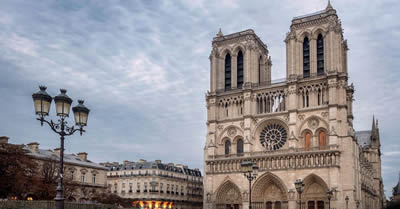Written by Isabelle DurantDeputy Secretary-General of UNCTAD
Some buildings – and indeed some spaces – transcend borders and represent global treasures.
Notre-Dame de Paris Cathedral is one of them.
Not only because it is a UNESCO World Heritage site – part of the 1991 listing of Paris, Banks of the Seine – but also because it is the emblem of a city, an entire nation and a part of its history.
Drawing a total of 12 million people annually, Notre-Dame is the most visited monument in the French capital.
On Tuesday evening, tragedy struck. The cathedral was severely damaged by a 15-hour fire.

This is the second time in a year that fire has ravaged a renowned cultural site.
In September 2018, fire destroyed the Brazilian Museu Nacional in Rio de Janeiro, founded in 1818, which housed an invaluable collection of 20 million artifacts.
Both were devastating losses not only to their countries but the whole world.
Such buildings illustrate the ability of people to collaborate, to innovate, to surpass themselves.
Buildings also personalize our dreams and visions for development and progress.
They also play a fundamental role in the creation of common goods and ultimately contribute to identity and social cohesion in cities and nations, acting as a cement between people.
It is also this importance that makes them targets in destructive conflicts – examples of which are the destruction of the ancient Syrian city of Palmyra and the Buddhas of Bamiyan.
They are also symbolic – and give materiality to what is often intangible, our culture.
People cherish culture.
The influx of messages of support, donations and grief also shows how much cultural sites such as Notre-Dame and the Museu Nacional, among others, are appreciated by visitors.
Here culture’s intrinsic value – basically what it means to people – is evident. It has significant weight, visible both through the way we practice our own culture and admire and respond to others.
This intrinsic value can, under certain conditions, have an economic value. The huge number of visitors to Notre-Dame is an indication of the appeal of such sites.
Let us not forget that creative and cultural tourism is a leading generator of GDP for local and national coffers globally.
UNCTAD has a long-standing commitment to the creative economy. But not the one that uncompromisingly standardizes and commercializes culture, rather the one at the service of culture that is focussed on improving the lives of everyone.
The tragedies in Paris and Rio de Janeiro should remind us of the importance of continuous investment in cultural sites.
If too little, or nothing, is done to maintain, restore and preserve such sites, we will experience further dramatic losses.
Fire destroys everything in its path.
This prompts us to recall that what we build can be destroyed, but also that reconstruction is possible, with the necessary political will and investment.
It also reminds me that if we want to meet our global sustainable development goals by 2030, we must tap into our vast cultural capital to change our behaviour.
I cannot help but draw a parallel between this cultural disaster and the natural disasters towards which we are heading if the Paris Agreement, a universal bulwark against them, is not implemented.


